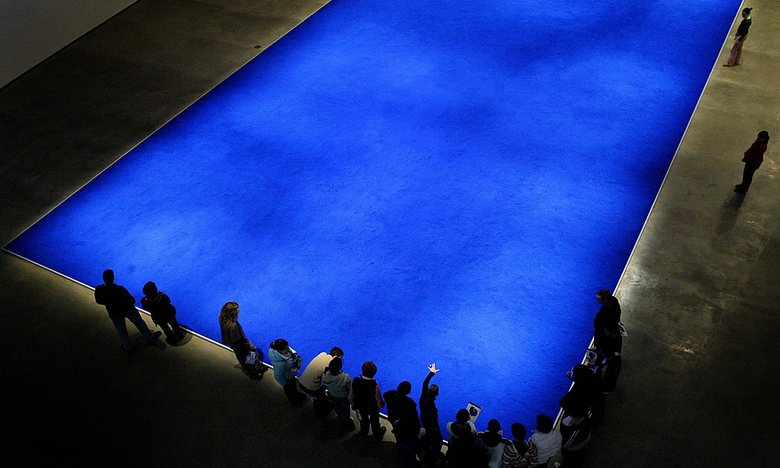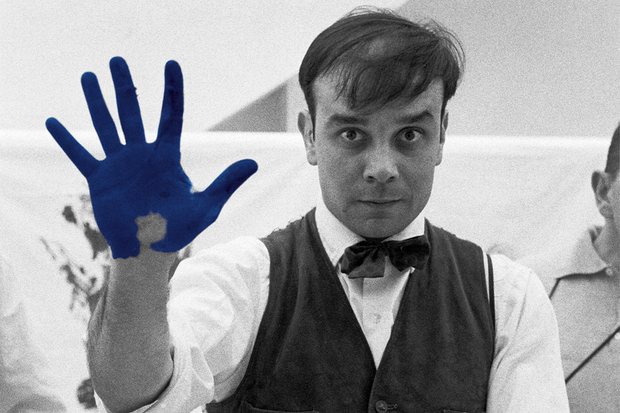The time Yves Klein spent working in a London frame shop was crucial to his artistic development, so why is it forgotten?
n 2006 the catalogue of the Yves Klein retrospective at the Centre Pompidou in Paris included a section in which different authors examined the significance of certain countries or cities for Klein’s artistic development – France, Germany, Italy, Japan, New York – and, conversely, the impact the artist made on the art scene in these places. The omission of London from this list was surprising. For Klein always maintained that his first monochromes were painted and exhibited in London during the months he spent there in 1949-50, when he was in his early 20s. He reminisced about his London apprenticeship in writing in 1959, three years before his untimely death. “To earn my living, I worked illegally for about a year in the Old Brompton Road frame shop of Robert Savage, a friend of my father. It was there, assisting in the preparation of size, colours, varnish, of gilt bases, that I became familiar with the material, with handling it ‘in bulk’.”
It is clear that the period Klein spent in Savage’s workshop was formative. It was there that he first experienced working with gesso, gold leaf, pastel and pure pigments – the very materials that he would later use in his art – learning about their properties and recognising their potential.
But who was Robert Savage? The Savage Gallery’s address was 65 Old Brompton Road, near South Kensington underground station. Down one side of it ran an alley, Barnaby Place, where the workshop was located (now part of Christie’s South Kensington). Savage was known for employing penniless young artists, many of them Australian, the best known of these being the painter Fred Williams. Apprentices at Savage’s began by moulding and sandpapering gesso frames in the basement. Williams eventually graduated to the ground floor, “restoring old master and contemporary paintings of great value”. He later described Savage’s as “the best art school in London”. A fellow Australian, Guy Warren, recalled how he and Williams would take home the discarded rectangular pieces cut from mount boards and paint on them in gouache. This was exactly Klein’s practice: “In my room at night, I did gouache monochromes on pieces of white cardboard, using, also, more and more pastels.”

An untitled work by Yves Klein at the Guggenheim Museum in Bilbao in 2005. Photograph: Vincent West/Reuters
The main purpose of Klein’s visit to London was to improve his English. During his time in London he rented a room at 69 Cromwell Road, a short walk from Savage’s. Klein often went to the Anglo-French Art Centre in St John’s Wood where his father, Fred Klein, had been given an exhibition in 1946. Klein’s mother, Marie Raymond, was also a painter, in the lyrical abstract or tachist style, who won the Prix Kandinsky in 1949. In an autobiographical note written in the third person, Klein described the influence of his family background: “Born into a milieu of artists and painters, Yves Klein was attracted to art and in particular to painting from the time of his childhood. With no feeling of rebellion vis-à-vis this milieu in which he lived, it is fair to say all the same that a certain irritation emerged in the course of his adolescence with regard to the very laws of composition of art and painting that he heard constantly discussed around him – a barely disguised lack of breadth, true freedom, and perspective.”
Without his parents’ connections, without the artistic and intellectual world they inhabited, it is tempting to ask whether Klein’s art would have taken the direction it did. The practical skills and understanding of materials that he learned in Savage’s picture framing and restoration workshop, for example, proved invaluable. Nevertheless, there can be little doubt that what Klein referred to as his “first exhibition of monochromes” in London in 1949 represented a decisive break with the School of Paris, and in particular the kind of art practised by his mother.
The “exhibition”, which took place in Klein’s bedsit, consisted of “monochrome gouaches in various hues painted on small pieces of white cardboard”. The gouaches were joined by small monochrome pastels which Klein tacked to the wall. He then invited a few friends to view them. Although no one at the time, including Klein himself, took them too seriously, there could be no turning back. As he told his friend, the poet Claude Pascal, “I have found what I want to do”.
Eight years later Klein returned to London to oversee the installation of his exhibition of 19 “Monochrome Propositions” and one blue sponge sculpture at Gallery One in Soho. Gallery One had been founded in 1953 by the poet Victor Musgrave and was dedicated to showing progressive and emerging art, especially from abroad. The art dealer Kasmin, then in his early 20s, was working part-time for Musgrave and part-time as an assistant to his wife, the portrait photographer Ida Kar. He has a clear memory of Klein, with whom he shared his tiny second-floor bedroom above the gallery, giving up his bed to the artist and sleeping on the floor. The two men got on well. Kasmin recalls Klein (who was six years his senior) as being focused, with a plan, not dissolute or drinking as other artists were at the time.
As well as promising Pernod and red wine, Klein’s private view card informed invitees that “due to the controversial nature of this work there will be a discussion open to all at the Institute of Contemporary Arts … at which M Yves Klein and M Pierre Restany the French art critic will answer questions”. Press coverage of the London exhibition was extensive. Writing in the Observer, a sceptical Alan Bowness summarised Klein’s ideas, commenting: “All this is quite lunatic, but M Klein’s good humour and astute arguments are altogether reassuring. If people are foolish enough to take such nonsense seriously one can only congratulate the hoaxer. What has confused the issue is the undeniable fact that M Klein has raised a genuine philosophical-mystical problem: that of the contemplation of colour by itself and for itself. But this has little to do with art.”
The majority of reviews were hostile, at best unconvinced. Klein was charged with being silly, a self-promoter, a “chancer” (Bernard Levin in the Spectator); with splashing on paint with a decorator’s roller, painting nothing, and charging extortionate sums for his work. Particular derision was reserved for “The Flower”, the blue sponge sculpture on its “stick” or “spike”, which the gallery priced at 75 guineas.
In his sarcastic Spectator article, Levin had called Klein’s blue paint “cheap poster-paint”. Musgrave corrected him in a letter to the editor, pointing out that Klein “prepares and grinds his own paint, an exacting process which gives it its own especial depth, brilliance and beauty”. This was Klein’s ultramarine blue, in which the radiance and intensity of the original dry pigment was not compromised or dulled by the medium binding it to the support; the artist later patented it in France as IKB (International Klein Blue).

Anthropome´trie sans titre (1961) by Yves Klein. Photograph: Yves Klein, ADAGP, Paris/DACS, London.
The exhibition following Klein’s was a mixed show of gallery artists, including Klein. Yet it appears that only one of Klein’s monochromes was sold during the summer of 1957. Klein was struggling financially, as his letters to Musgrave painfully attest, and could certainly have done with more sales. He must have renewed contact with Savage when in London. Writing to Musgrave after the opening at Gallery One, he wonders if Savage has been to see the exhibition: “I think he could buy a picture if you ask him a little friendly perhaps!?” But in spite of lack of sales he was keen for Musgrave to choose a painting for himself – “the best one and keep it with all my true friendship and deep ‘estime’”.
Although he died young and hard-up, Klein is one of the most radical figures in postwar western art. He influenced minimal, conceptual and performance art, taking painting out of the frame, which he felt had imprisoned it for too long. His monochromes, hung several inches in front of the wall, were intended to saturate the viewer’s space. Klein also blurred the boundaries between painting and sculpture by impregnating a range of objects, from sponges to plaster casts, with his signature blue. In his “anthropometries”, he helped naked female models smothered in paint to impress their moving bodies on large sheets of paper. He invented a number of other strategies to depersonalise and dematerialise the art object, including using fire and presenting empty space (“the void”), which he felt was pregnant with possibilities. Much of his work has a spiritual or transcendental quality. Given the importance of London in Klein’s artistic development, a campaign has been launched to have an English Heritage plaque placed on the house in Cromwell Road. Perhaps it could be in International Klein Blue.


Be the first to comment on "Yves Klein and the birth of the blue"